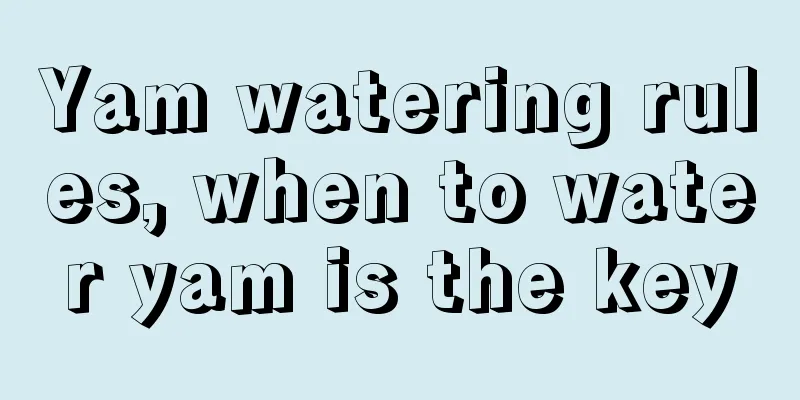Yam watering rules, when to water yam is the key

1. Watering rules1. Don’t water unless the soil is dry: Yam is a plant that has a certain degree of drought resistance and is a tuber. Once the environment is too humid, it will easily affect its breathing and is not conducive to the growth of the plant. For potted plants, be sure to water them after the soil is dry. Each time you water, you must water thoroughly. This way, alternating between dry and wet will be more conducive to the plant's absorption of water. 2. Shallow watering to prevent waterlogging: For yam planted in the ground, the soil is not so easy to dry out, so the frequency of watering does not need to be too high. In the early stage, there is no need to water as long as the topsoil is moist below 5 cm. Wait until the plant grows to 1 meter high for the first watering, and the second watering after 20 days. These two waterings should be shallow, and not flooding with large amounts of water. When the tubers are in the swelling stage, if the soil is dry, it needs to be watered thoroughly. In addition, in autumn, attention should be paid to drainage to avoid waterlogging. 2. Watering timeThe best time to water yam is in the morning or evening, and be sure to avoid watering at noon. Because the light is strong and the temperature is relatively high at noon, water is easily lost after watering, making it unable to absorb enough water. In addition, there is no need to water during the rainy season. The environment is relatively humid, and water is easily accumulated after watering, affecting the breathing of the roots. 3. NotesYam itself does not require much water. If you water it too much, it will affect the growth of the plant. Especially if there is waterlogging in the pot soil, it will affect the breathing of the roots and may cause them to rot over time. To prevent root rot caused by overwatering, the first thing to do is to drain the water and increase air circulation to allow the water to evaporate as quickly as possible. If the situation does not improve, it needs to be removed from the pot, the rotten roots need to be properly trimmed, and then replanted. |
<<: Can orchids use bean cake fertilizer? How to apply cake fertilizer to orchids
>>: What fertilizer should be used to grow yam? What fertilizer is best for growing yam?
Recommend
Can the leaves of the lucky tree survive after being freeze-dried?
1. Can I still live? This type of plant does not ...
How to grow bird of paradise more vigorously?
Bird of Paradise, also known as Strelitzia regina...
The main value of seven flowers
Ornamental value First of all, they are unique to...
How to make bonsai of Photinia chinensis
Production time The production time of Chinese ph...
Pests of Iris and Their Control
Pests of Iris and Their Control Iris is a plant t...
How often should I water my ping pong chrysanthemum? How many days should I water it?
How often should I water my ping pong chrysanthem...
How many kilograms of apples are usually produced per acre? How many kilograms of apples are produced per acre?
Apple yield per acre Apple is a common fruit. Its...
Cultivation methods and precautions of Sansevieria in winter. Will it freeze to death?
1. Breeding methods 1. Keep warm indoors: Sansevi...
What is the reason why the edges of strawberry leaves turn black and dry?
The nutrients needed for strawberry growth mainly...
The flower language of hyacinth, pictures of hyacinth flowers
1. The flower language of hyacinth 1. Ignite the ...
What fertilizer is good for growing mung beans?
Mung bean fertilizer Mung beans have the ability ...
Is the yield of flat peach high? What is the yield per mu?
Is the yield of peaches high? The yield of peache...
Why are the leaves of Tiger Eye Evergreen turning yellow?
Caused by lack of water If the leaves of a newly ...
If you don’t know these summer care tips, your succulents will surely die!
Summer type Summer growing succulents 1 Summer Ti...
Where does water hyacinth grow?
1. Where does it grow? Its scientific name is Eic...









